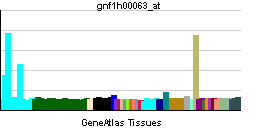KCNK6
| Potassium channel, subfamily K, member 6 | |||||||||||
|---|---|---|---|---|---|---|---|---|---|---|---|
| Identifiers | |||||||||||
| Symbols | KCNK6 ; FLJ12282; K2p6.1; KCNK8; TOSS; TWIK-2; TWIK2 | ||||||||||
| External IDs | Template:OMIM5 Template:MGI HomoloGene: 31266 | ||||||||||
| |||||||||||
| RNA expression pattern | |||||||||||
 | |||||||||||
| More reference expression data | |||||||||||
| Orthologs | |||||||||||
| Template:GNF Ortholog box | |||||||||||
| Species | Human | Mouse | |||||||||
| Entrez | n/a | n/a | |||||||||
| Ensembl | n/a | n/a | |||||||||
| UniProt | n/a | n/a | |||||||||
| RefSeq (mRNA) | n/a | n/a | |||||||||
| RefSeq (protein) | n/a | n/a | |||||||||
| Location (UCSC) | n/a | n/a | |||||||||
| PubMed search | n/a | n/a | |||||||||
Potassium channel, subfamily K, member 6, also known as KCNK6, is a human gene.[1]
This gene encodes one of the members of the superfamily of potassium channel proteins containing two pore-forming P domains. This channel protein, considered an open rectifier, is widely expressed. It is stimulated by arachidonic acid, and inhibited by internal acidification and volatile anaesthetics.[1]
See also
References
Further reading
- Goldstein SA, Bockenhauer D, O'Kelly I, Zilberberg N (2001). "Potassium leak channels and the KCNK family of two-P-domain subunits". Nat. Rev. Neurosci. 2 (3): 175–84. PMID 11256078.
- Goldstein SA, Bayliss DA, Kim D; et al. (2006). "International Union of Pharmacology. LV. Nomenclature and molecular relationships of two-P potassium channels". Pharmacol. Rev. 57 (4): 527–40. doi:10.1124/pr.57.4.12. PMID 16382106.
- Mahboubi S, Kaufmann JH (1978). "Intramural duodenal hematoma in children. The role of the radiologist in its conservative management". Gastrointestinal radiology. 1 (2): 167–71. PMID 1088718.
- Maruyama K, Sugano S (1994). "Oligo-capping: a simple method to replace the cap structure of eukaryotic mRNAs with oligoribonucleotides". Gene. 138 (1–2): 171–4. PMID 8125298.
- Suzuki Y, Yoshitomo-Nakagawa K, Maruyama K; et al. (1997). "Construction and characterization of a full length-enriched and a 5'-end-enriched cDNA library". Gene. 200 (1–2): 149–56. PMID 9373149.
- Chavez RA, Gray AT, Zhao BB; et al. (1999). "TWIK-2, a new weak inward rectifying member of the tandem pore domain potassium channel family". J. Biol. Chem. 274 (12): 7887–92. PMID 10075682.
- Salinas M, Reyes R, Lesage F; et al. (1999). "Cloning of a new mouse two-P domain channel subunit and a human homologue with a unique pore structure". J. Biol. Chem. 274 (17): 11751–60. PMID 10206991.
- Pountney DJ, Gulkarov I, Vega-Saenz de Miera E; et al. (1999). "Identification and cloning of TWIK-originated similarity sequence (TOSS): a novel human 2-pore K+ channel principal subunit". FEBS Lett. 450 (3): 191–6. PMID 10359073.
- Gray AT, Kindler CH, Sampson ER, Yost CS (1999). "Assignment of KCNK6 encoding the human weak inward rectifier potassium channel TWIK-2 to chromosome band 19q13.1 by radiation hybrid mapping". Cytogenet. Cell Genet. 84 (3–4): 190–1. PMID 10393428.
- Patel AJ, Maingret F, Magnone V; et al. (2000). "TWIK-2, an inactivating 2P domain K+ channel". J. Biol. Chem. 275 (37): 28722–30. doi:10.1074/jbc.M003755200. PMID 10887187.
- Strausberg RL, Feingold EA, Grouse LH; et al. (2003). "Generation and initial analysis of more than 15,000 full-length human and mouse cDNA sequences". Proc. Natl. Acad. Sci. U.S.A. 99 (26): 16899–903. doi:10.1073/pnas.242603899. PMID 12477932.
- Mhatre AN, Li J, Chen AF; et al. (2004). "Genomic structure, cochlear expression, and mutation screening of KCNK6, a candidate gene for DFNA4". J. Neurosci. Res. 75 (1): 25–31. doi:10.1002/jnr.10839. PMID 14689445.
- Ota T, Suzuki Y, Nishikawa T; et al. (2004). "Complete sequencing and characterization of 21,243 full-length human cDNAs". Nat. Genet. 36 (1): 40–5. doi:10.1038/ng1285. PMID 14702039.
- Gerhard DS, Wagner L, Feingold EA; et al. (2004). "The status, quality, and expansion of the NIH full-length cDNA project: the Mammalian Gene Collection (MGC)". Genome Res. 14 (10B): 2121–7. doi:10.1101/gr.2596504. PMID 15489334.
External links
- KCNK6+protein,+human at the US National Library of Medicine Medical Subject Headings (MeSH)
| Stub icon | This membrane protein–related article is a stub. You can help Wikipedia by expanding it. |
This article incorporates text from the United States National Library of Medicine, which is in the public domain.